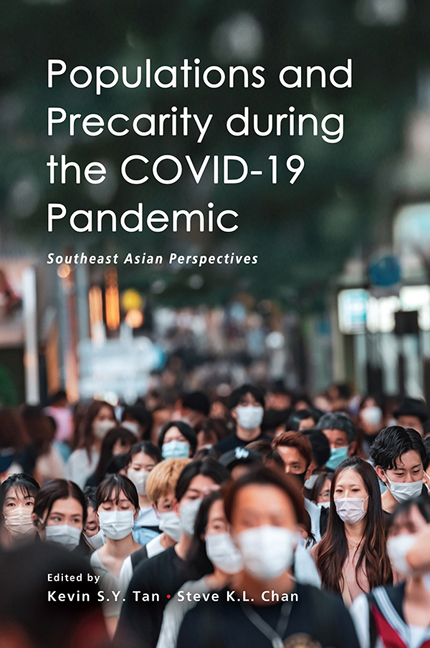Book contents
- Frontmatter
- Contents
- Preface
- About the Contributors
- 1 Introduction: Populations, Precarity and the COVID-19 Pandemic
- 2 Transformation of the Family Structure in Southeast Asia: Trends and Implications
- 3 New Normal, Old Ties: COVID-19’s Social Impact on the Singapore-Johor Bahru Connection
- 4 Unequal Flows: Examining the Factors Surrounding Thai and Vietnamese Labour Migration to South Korea
- 5 Emplacing Multiculturalism: Southeast Asian Migrant Linguistic Acculturation Programmes and Community Building in South Korea
- 6 “Foreign Talent” in Singapore and Some Implications for Schools
- 7 Managing Disaster Risk and Enabling Social Protection in Thailand: Some Lessons from the COVID-19 Pandemic
- 8 Transnational Housing Insecurity: Mobility, Homelessness, and the COVID-19 Pandemic
- 9 Older Persons with Hearing Disabilities in Indonesia: Vulnerability and Demographic Diversity during the COVID-19 Pandemic
- Index
5 - Emplacing Multiculturalism: Southeast Asian Migrant Linguistic Acculturation Programmes and Community Building in South Korea
Published online by Cambridge University Press: 01 March 2024
- Frontmatter
- Contents
- Preface
- About the Contributors
- 1 Introduction: Populations, Precarity and the COVID-19 Pandemic
- 2 Transformation of the Family Structure in Southeast Asia: Trends and Implications
- 3 New Normal, Old Ties: COVID-19’s Social Impact on the Singapore-Johor Bahru Connection
- 4 Unequal Flows: Examining the Factors Surrounding Thai and Vietnamese Labour Migration to South Korea
- 5 Emplacing Multiculturalism: Southeast Asian Migrant Linguistic Acculturation Programmes and Community Building in South Korea
- 6 “Foreign Talent” in Singapore and Some Implications for Schools
- 7 Managing Disaster Risk and Enabling Social Protection in Thailand: Some Lessons from the COVID-19 Pandemic
- 8 Transnational Housing Insecurity: Mobility, Homelessness, and the COVID-19 Pandemic
- 9 Older Persons with Hearing Disabilities in Indonesia: Vulnerability and Demographic Diversity during the COVID-19 Pandemic
- Index
Summary
Introduction
Over the last generation the Vietnamese migrant population in South Korea has grown significantly and become quite visible. Vietnamese in South Korea number over 170,000 and now count as the largest expatriate population in the country after Chinese (Park 2018). One of the most significant remittance corridors is now South Korea-Vietnam, which has outpaced Overseas Development Assistance (ODA) flows. The majority of Vietnamese in Korea tend to fall into three categories— labour migrants, spouses, and students. Migrant labour from Vietnam to South Korea dates to the 1990s, and since 2004 an E-9 Employment Permit System and C-4 seasonal visas place Vietnamese in long and short-term contract positions in factories, agriculture and aquaculture throughout the country. Marriage migration, in which South Korean men contract matchmaking agencies and arrange tours to identify suitable Vietnamese women for marriage, rose quickly in the 2000s. In 2009, 47 per cent of foreign marriages in South Korea were to Vietnamese, and the first decade of the twenty-first century alone saw the number of Vietnamese-Korean cross border marriages increase one hundred-fold (Onishi 2007; Kim 2012). Marriage migration to Korea is often associated with younger women marrying rural bachelors as well as taking on ageing in-law care duties. Driven in part by South Korea's low birth rate, ageing population, rural-urban migration, rapid industrialization, and tourism to and targeted investment in Vietnam, the demand for foreign migrants in South Korea has steadily risen. This also extends to education, where Korean universities have sought to boost declining domestic enrollment numbers by recruiting more overseas students (Nguyen 2018). Mirroring the general foreign population, Vietnamese students in South Korea rank the highest among international students, along with Chinese. There are over 44,000 Vietnamese marriage migrants, over 50,000 labourers, and over 59,000 students according to recent reports (Lee 2022; ILO 2021; Kim 2021). There is also a significant population of undocumented workers living below the official radar.
Not surprisingly these migration streams have led to various discontents and calls for intervention, including addressing the high migrant broker fees paid prior to migration and disillusionment often encountered by migrants afterwards (Song 2015).
- Type
- Chapter
- Information
- Populations and Precarity during the COVID-19 PandemicSoutheast Asian Perspectives, pp. 68 - 83Publisher: ISEAS–Yusof Ishak InstitutePrint publication year: 2023



